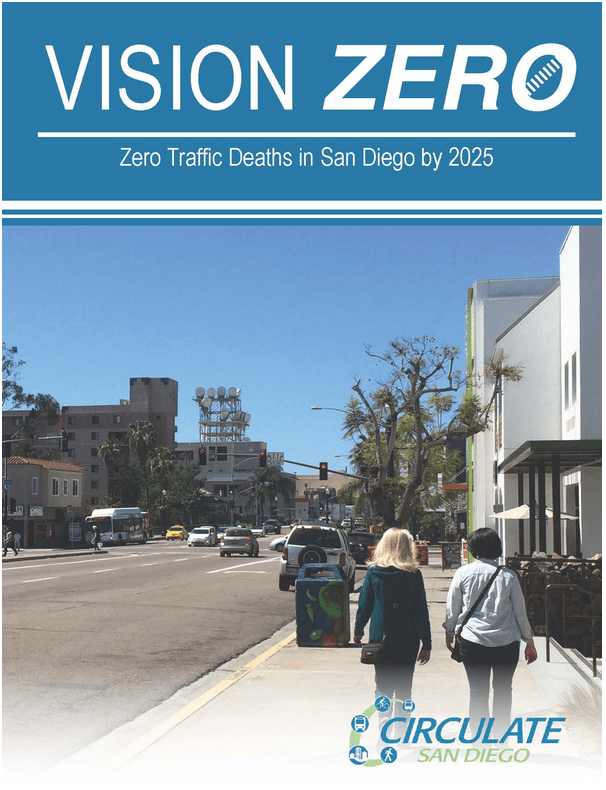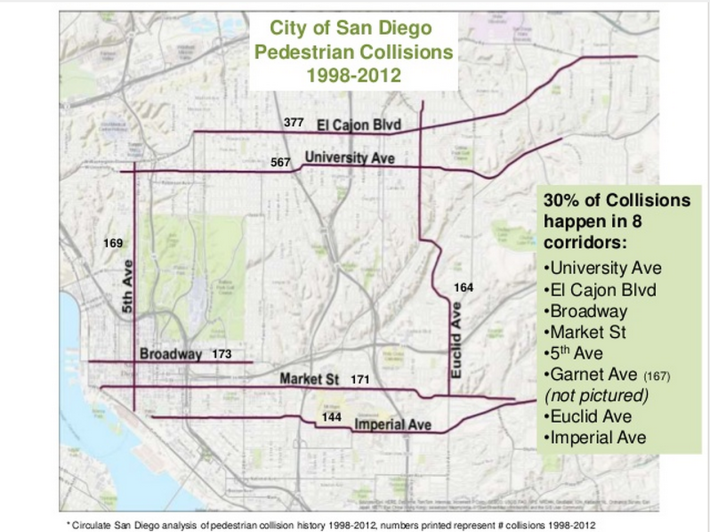Flanked by city officials, fellow elected officials, the chief of police and the head of the progressive transportation advocacy group Circulate San Diego, Mayor Kevin Faulconer announced their support for San Diego to embrace Vision Zero. Faulconer promises his administration will produce a plan to reduce traffic deaths in the city to zero through progressive transportation planning and law enforcement that puts safety above all other considerations.

Vision Zero is modeled after the Swedish Government's initiative to use progressive transportation planning and law enforcement to reduce the number of transportation-related fatalities to zero. In Sweden, the plan has proved an overwhelming success. Only three of every 100,000 Swedes die in traffic crashes. Prior to the implementation of Vision Zero policies in 1997, that number was seven of every 100,000 Swedes killed in traffic crashes.
This compares with 5.5 per 100,000 across the European Union, and 11.4 in America. Sweden’s roads are the safest in the world. America has over three times as many per capita fatalities.
”There is nothing more important than public safety, which is why we’re working toward the goal of zero traffic deaths in the City of San Diego,” Mayor Faulconer said. “We’re making great strides to become a more pedestrian- and bicycle-friendly city by investing in our infrastructure and making safety a top priority in all street projects. Whether you drive, bike, or walk, safer streets benefit everyone.”
While San Diego may be making strides, there is a lot of room for the city to improve its safety record. According to Vision Zero: Zero Traffic Deaths in San Diego by 2025, a report released in conjunction with today's press conference by Circulate San Diego,
On average, one person each day is seriously injured or killed while walking, biking, or driving the streets of the City of San Diego...Fatalities among people driving have continuously fallen since 2005, yet fatalities among people walking have increased or remained static in the same time frame, outpacing population growth.
In addition, traffic collisions are the leading cause of deaths for children aged 0-13 in the city.
According to Circulate’s Director Jim Stone, “Vision Zero is an idea whose time has come in San Diego. We owe it to San Diegans to have safe streets. No loss of life is acceptable.”
American cities that have embraced Vision Zero have not done so as fully as Sweden and have shown different results. In New York, Mayor Bill DeBlasio seems to receive pushback on even common-sense reforms such as laws that allow the city to prosecute bus drivers who kill pedestrians and cyclists who have the right-of-way and the NYPD is still executing ticketing blitzes against cyclists despite the low number of people killed by bicyclists.
In San Francisco, a report released in February by safety advocates noted the city was achieving the basics such as buy-in from city agencies and the public, but had yet to pursue more dramatic changes to the city's infrastructure designed to make moving around the city more safe.
There have also been some more off-the-wall ideas, such as Seattle's plan to hand out Starbucks gift cards to road users who obey the law.
But it's still the most obvious fixes that have the best results. The Vision Zero Network recently published a piece on five lessons learned from the success Vision Zero has had in Europe. Not surprisingly, reducing vehicle traffic speed and redesigning streets are the efforts that have shown the most success, while education campaigns have had a more limited impact. The report also encouraged building public support as well as constantly innovating and not settling for improved results unless those results are zero traffic fatalities.
The statistics on where traffic crashes and fatalities occur in San Diego provides the city with some excellent places to start their Vision Zero improvements. According to Circulate, one is ten times as likely to be hit by a car in a disadvantaged community than in other parts of the city. On top of that, 30% of crashes happen along just eight corridors in a city that is over 372 square miles large.
This is not to say that there is a one-sized-fits-all approach to fixing the roadway network in San Diego. University Ave., 5th Street, and Broadway are all key thoroughfares and packed with pedestrians. Reducing vehicle speed and adding more pedestrian infrastructure, lit crosswalks, a road diet, and bike lanes will undoubtedly help to reduce conflict between cars and those on foot or bike. Ensuring cars do not pick up speed as they transition out of slower zones and that moving onto or off the many freeways that criss-cross San Diego's neighborhoods is more orderly may also be important in reducing overall collisions. In lower-income communities, improved communication between law enforcement, planners, and communities may be needed to accompany any infrastructure fixes.
While Faulconer should be lauded for his support of creating a Vision Zero plan and his belief that "Every San Diegan deserves to feel safe in his or her neighborhood," today's announcement marks only the beginning of the journey for the city and its communities. It's one thing to embrace a vision, but another to make that vision a reality.






